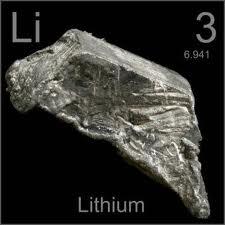|
|
| Lithium is the first of the alkalis in the periodic table. In nature it’s found like a mixture of the isotopes Li6 and Li7. It’s the lightest solid metal, it’s soft, silvery-white, with a low melting point and reactive. Many of its physical and chemical properties are more similar to those of the alkaline earth metals than to those of its own group. Between the most significant properties of lithium we find its high specific heat (calorific capacity), the huge temperature interval in the liquid state, high termic conductivity, low viscosity and very low density. Metallic lithium is soluble in short chain aliphatic amines, like etilamine. It’s insoluble in hydrocarbons. Applications The main lithium compound is the lithium hydroxide. It’s a white powder; the manufactured material is monohydrate lithium hydroxide. The carbonate can be used in the pottery industry and in medicine as an antidepressant. The bromine and the lithium chloride both form concentrated brine, which have the property of absorbing the humidity in a wide interval of temperature; these brines are used in the manufactured air conditioning systems. |
Read more: http://www.lenntech.com/periodic/elements/li.htm#ixzz10Hb1Fb5F
